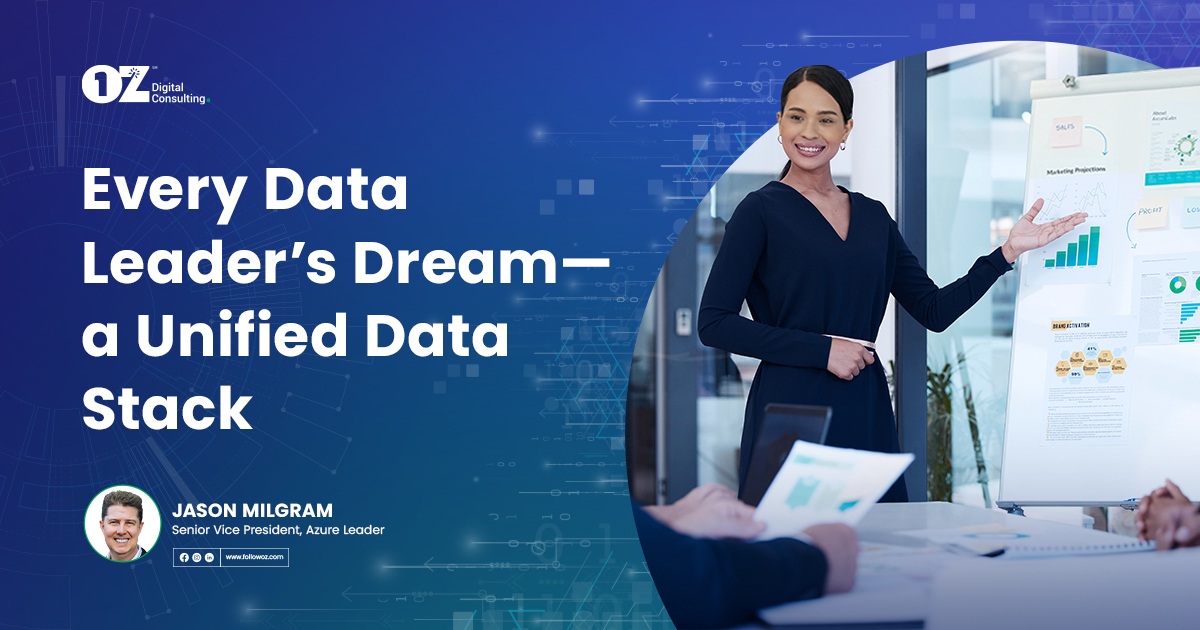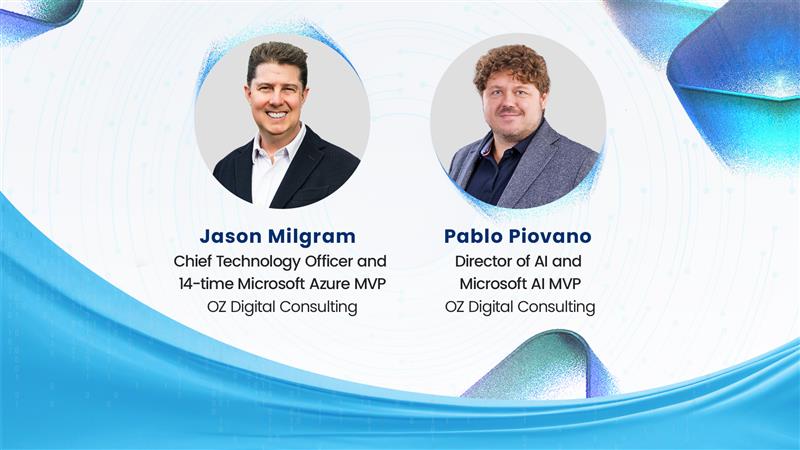By Jason Milgram, Senior Vice President, Azure Leader
Data leaders everywhere can now breathe a sigh of relief as they finally have access to Microsoft Fabric — and a unified data stack. This latest offering from Microsoft brings all your data together in one place on one platform. But before delving into how Microsoft Fabric could be a boon for data leaders, let’s first explore why it has sparked excitement within the data community.
With the spotlight on artificial intelligence (AI), organizations across the board are eager to leverage its potential. 87% of organizations believe that AI will give them a competitive edge. For data leaders, this translates to a growing pressure to expedite AI projects across their organizations. But, as they prepare for an AI future, they must also ensure they have clean data to make AI work.
Is Your Data Ready for AI?
Only 4% of the world’s data is ready for AI, according to Gartner.
AI innovation requires a well-orchestrated data estate that can support a spectrum of AI projects, from specialized initiatives to scalable solutions across the entire company. For many organizations whose data environments have evolved organically over time, resulting in a patchwork of specialized and disjointed solutions, it could pose a significant challenge.
Data is often stored in myriad locations—virtual and geographical—including operational databases, data warehouses, and data lakes, leading to silos and chaos where disparate systems operate independently of one another.
The consequences of such a complex data estate are manifold: data sprawl, duplication, infrastructure inefficiencies, limited interoperability, and greater data exposure risks, altogether hindering AI integration.
Applying advanced analytics and machine learning to such disparate data can be equally challenging, putting valuable insights out of reach.
In the age of AI, fragmented solutions that don’t seamlessly integrate across the organization are no longer tenable. Instead, what you need is a comprehensive data analytics solution that integrates and transforms data into actionable insights. This task often falls on data leaders who must sift through a myriad of data and AI offerings, identifying the right set of services, integrating them effectively, and ensuring scalability and flexibility over time. However, most data leaders would rather focus on the outcomes of their tools rather than spend all their time integrating specialized solutions and maintaining their data estate. This is precisely where Microsoft Fabric comes into play.
Microsoft decided a complete overhaul was long due. To paraphrase their statement to the press, there’s a goldmine of opportunity in modern data stacks, except they’re too disorganized to benefit from it:
“Over the last five to 10 years, there has been a pretty massive level of innovation — which is great, and that’s awesome because there’s lots of new technologies out there — but it’s also caused a lot of fragmentation of the modern data stack,” says Arun Ulag, Microsoft’s corporate VP for Azure Data. “There’s literally hundreds—if not thousands—of products and open source technologies and solutions that customers have to make sense of.” He also noted that a lot of the data and analytics products tend to keep their data in silos.
With Microsoft Fabric, he adds, “There’s a unified compute infrastructure; there’s a unified data lake. There’s a unified product experience for all your data professionals so that they can really collaborate deeply. [There’s] unified governance so that IT can manage this and create sources of truth that everybody can trust, and really a unified platform that both IT and business share — and the unified business model. There’s literally just one thing to buy, and it allows customers to save a lot of costs, which, especially in today’s environment, is really important.”
Fabric’s feature list is impressive, but here’s what we think makes it sing:
- Integrates Data Management
Microsoft Fabric represents a drastic shift in how data is managed, consolidating all data and analytics tools into a single, integrated experience. Moving away from disparate services to a unified stack, Fabric streamlines operations by transitioning from multiple databases to a unified data lake, from generative AI bolted on to generative AI built in. - Connects Data from Any Cloud or Database
With Fabric, teams can use shortcuts and mirroring to connect data from any cloud or database directly into Fabric’s data lake, OneLake, often without duplication or migration. Once within OneLake, you can access and work with a single copy of the data across multiple engines and data formats. For instance, Fabric enables direct access to OneLake data through Excel, facilitating analysis and report generation with a single click. - Brings Together the Best of Data Lakes and Data Warehouses
A platform like Microsoft Fabric provides you with an entirely new way to store your data, bringing the best of both worlds — from the data warehouse and data lake models — into one “data lakehouse.”
So, what is a data lakehouse? It’s a hybrid architecture that lets you store all your data in a data lake and run AI and BI on that data directly — at scale. It has the SQL and performance capabilities (indexing, caching, MPP processing) to make BI work fast on data lakes. It also has direct file access and direct native support for Python, data science, and AI frameworks without ever forcing it through a SQL-based data warehouse.
Provisioning a data lakehouse in Microsoft Fabric means you only need one data repository instead of both warehouse and lake infrastructure. With a data lakehouse, you can streamline your overall data management process and break down data silos — all in one unified platform.
This integration creates a more efficient end-to-end process with several benefits:
- Better data governance: Data lakehouses improve governance by consolidating data sources. A standardized open schema allows greater control over security, metrics, role-based access, and management.
- Simplified standards: Localized schema standards were often created within organizations using data warehouses. Today, open schema standards exist for many types of data, and data lakehouses make the most of them by ingesting multiple data sources with an overlapping standardized schema to simplify processes.
- Cost-effectiveness: The data lakehouse infrastructure separates compute and storage, making it easy to add storage without adding compute power.
- Better data governance: Data lakehouses improve governance by consolidating data sources. A standardized open schema allows greater control over security, metrics, role-based access, and management.
Allows You to Explore Data from Any Source
Featuring an extensive suite of services encompassing data connectors, engineering tools, data science, and analytics workflows, Microsoft Fabric lets you access and explore data from any source effortlessly. The Data Factory workload alone offers over 150 connectors to diverse data sources, facilitating extensive connectivity through data flows and pipelines. Moreover, Fabric seamlessly integrates Azure OpenAI Service at every layer, allowing enterprises to channel the power of AI and GPT-powered CoPilot for tasks such as creating data pipelines, generating code, and building models using natural language.
Prepares Your Data for AI
AI-powered features like Copilot enhance productivity across the board, whether creating dataflows and pipelines, crafting SQL statements, or generating reports. Microsoft Fabric helps you build, deploy, and manage AI models through various tools and frameworks. Rather than spending excessive time collecting and cleansing data before building models, you can use Synapse Data Science, which offers built-in machine-learning capabilities. The Azure ML-powered MLFlow model and the SynapseML Spark library further accelerate the data science workflow, significantly boosting efficiency.
With Copilot in Microsoft Fabric, you can create dataflows and data pipelines, generate code and entire functions, build machine learning models, or visualize results. By combining Azure OpenAI Service models and your data, you can create and use plug-ins for various use cases.
Reduces Costs
By consolidating all necessary tools within a unified Software as a Service (SaaS) experience, Microsoft Fabric streamlines integration efforts, reducing costs, and minimizing the complexity of managing diverse data environments. The insights you uncover flow securely into the Microsoft 365 applications your teams use every day, improving decision making and driving meaningful impact.
In essence, Microsoft Fabric represents a massive leap forward in data management and analytics, helping organizations get more value out of their data assets while driving innovation and profitable growth in the age of AI. With a range of built-in solutions and tools tailored for specific business scenarios, Microsoft Fabric caters to diverse set of users within the data enterprise, all while utilizing OneLake as a centralized data source.
Fabric shows us that the dream of a modular and integrated data stack is possible.
How to get started with Microsoft Fabric
If you’d like to unleash your data’s potential, simplify data management, reduce costs, and complexity with a unified analytics solution like Microsoft Fabric, contact us.
Explore additional resources to learn about Microsoft Fabric
If you want to learn more about Microsoft Fabric, consider:
- Reading more blogs on Microsoft Fabric here.
- Connect with our Microsoft Fabric expert.
- Joining the Fabric community.



